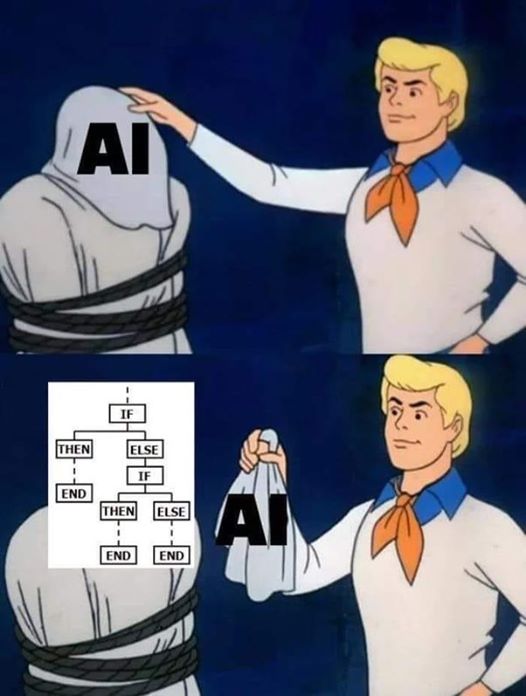Today's AI is increasingly becoming an oxymoron, as a fake reality and false truth, or a counterfeit AI in terms of "Machine Learning, Deep Learning and Artificial Neural Networks".

We suggest to apply Machine Intelligence and Learning (MIL) instead of AI, Machine Learning, Deep Learning and Artificial Neural Networks.
MIL is all about three interrelated universes: reality/world/environment; intelligence/intellect/mind/understanding; and its data/information/knowledge universe, how it is represented, mapped, coded and processed by computing machinery of any complexity, from smart phones to the internet and beyond.
MIL is the science and engineering of mind, intelligence or intellect, its nature, models, theories, algorithms, architectures and applications.
Machine Intelligence and Learning (MIL): If AI is an oxymoron, and why Turing never used it... https://www.linkedin.com/pulse...
"IT WILL BE as if the world had created a second China, made not of billions of people and millions of factories, but of algorithms and humming computers.
PwC, a professional-services firm, predicts that artificial intelligence (AI) will add $16trn to the global economy by 2030. The total of all activity—from banks and biotech to shops and construction—in the world’s second-largest economy was just $13trn in 2018.
PwC’s claim is no outlier. Rival prognosticators at McKinsey put the figure at $13trn. Others go for qualitative drama, rather than quantitative. Sundar Pichai, Google’s boss, has described developments in AI as “more profound than fire or electricity”. Other forecasts see similarly large changes, but less happy ones. Clever computers capable of doing the jobs of radiologists, lorry drivers or warehouse workers might cause a wave of unemployment.
Yet lately doubts have been creeping in about whether today’s AI technology is really as world-changing as it seems. It is running up against limits of one kind or another, and has failed to deliver on some of its proponents’ more grandiose promises".
If "Machines can Think", or MIL as Intelligent Computing Machinery
If "machines can think" is now 70-years-old scientific question since Turing’s “Computing Machinery and Intelligence’ article, published in Mind Journal in 1950; Mind, Volume LIX, Issue 236, October 1950, Pages 433–460.
Many smart minds and intellects have had their best tries to give the best answers.
Still we are in a big doubt: if machines can think. In his imitation game, Turing suggested such a possibility for all-equivalent digital electronic computers mimicking‘discrete state machines’ consisting of three elements:
Store/Memory;
Executive unit, CPU, GPU, brain or neural networks;
Control, operating systems, mind or intelligence.
To program a computer to carry out intellectual functions means to put the appropriate instruction table into the machine, as proper intelligent programming.
Turing had convincingly refuted opinions opposed to “the imitation game, or intelligent computing machinery.
(1) The Theological Objection
Thinking is a function of man's immortal soul. God has given an immortal soul to every man and woman, but not to any other animal or to machines. Hence no animal or machine can think.
(2) The ‘Heads in the Sand’ Objection
“The consequences of machines thinking would be too dreadful. Let us hope and believe that they cannot do so.”
(3) The Mathematical Objection
There are a number of results of mathematical logic which can be used to show that there are limitations to the powers of discrete-state machines. The best known of these results is known as Gödel's theorem, and shows that in any sufficiently powerful logical system statements can be formulated which can neither be proved nor disproved within the system, unless possibly the system itself is inconsistent.
(4) The Argument from Consciousness
“Not until a machine can write a sonnet or compose a concerto because of thoughts and emotions felt, and not by the chance fall of symbols, could we agree that machine equals brain—that is, not only write it but know that it had written it. No mechanism could feel (and not merely artificially signal, an easy contrivance) pleasure at its successes, grief when its valves fuse, be warmed by flattery, be made miserable by its mistakes, be charmed by sex, be angry or depressed when it cannot get what it wants.” According to the most extreme form of this view the only way by which one could be sure that a machine thinks is to be the machine and to feel oneself thinking.
(5) Arguments from Various Disabilities
These arguments take the form, “I grant you that you can make machines do all the things you have mentioned but you will never be able to make one to do X”. Numerous features X are suggested in this connexion. I offer a selection:
Be kind, resourceful, beautiful, friendly, have initiative, have a sense of humour, tell right from wrong, make mistakes, fall in love, enjoy strawberries and cream, make some one fall in love with it, learn from experience, use words properly, be the subject of its own thought, have as much diversity of behaviour as a man, do something really new.
6) Lady Lovelace's Objection
“The Analytical Engine has no pretensions to originate anything. It can do whatever we know how to order it to perform”.
(7) Argument from Continuity in the Nervous System
The nervous system is certainly not a discrete-state machine. A small error in the information about the size of a nervous impulse impinging on a neuron, may make a large difference to the size of the outgoing impulse. It may be argued that, this being so, one cannot expect to be able to mimic the behaviour of the nervous system with a discrete-state system.
(8) The Argument from Informality of Behaviour
It is not possible to produce a set of rules purporting to describe what a man should do in every conceivable set of circumstances.
But in the end he reduced his position to Reinforcement Learning Machine, much complicating the whole future of thinking computers planned to overcome the Turing Test by 2000. “Instead of trying to produce a programme to simulate the adult mind, why not rather try to produce one which simulates the child's? If this were then subjected to an appropriate course of education one would obtain the adult brain”. It is possible to teach a machine by punishments and rewards to obey orders given in some language, e.g. a symbolic language.
Still Turing discussed the child machine optimal design.
One might try to make it as simple as possible consistently with the general principles.
Alternatively one might have a complete system of logical inference ‘built in’.
In the latter case the store would be largely occupied with definitions and propositions. The propositions would have various kinds of status, e.g. well-established facts, conjectures, mathematically proved theorems, statements given by an authority, expressions having the logical form of proposition but not belief-value. Certain propositions may be described as ‘imperatives’.
The machine should be so constructed that as soon as an imperative is classed as ‘well-established’ the appropriate action automatically takes place. And we can “have a clear mental picture of the state of the machine at each moment in the computation”.
Turing conclude his classical article, which never used an oxymoron “artificial intelligence”.
We may hope that machines will eventually compete with men in all purely intellectual fields. But which are the best ones to start with?
Even this is a difficult decision. Many people think that a very abstract activity, like the playing of chess, would be best. It can also be maintained that it is best to provide the machine with the best sense organs that money can buy, and then teach it to understand and speak English. This process could follow the normal teaching of a child. Things would be pointed out and named, etc.
Again I do not know what the right answer is, but I think both approaches should be tried.
Resources
Marrying MINDS and MACHINES to form a global SUPERMIND: Surviving and thriving in a post-pandemic WORLD
https://cont.ws/@ashacontws/18...
Artificial intelligence and its limits An understanding of AI’s limitations is starting to sink in








Оценили 0 человек
0 кармы